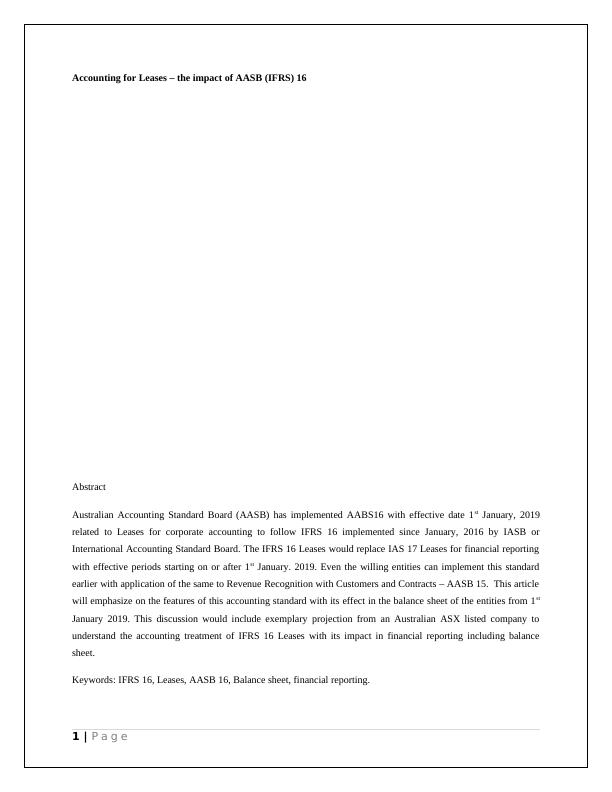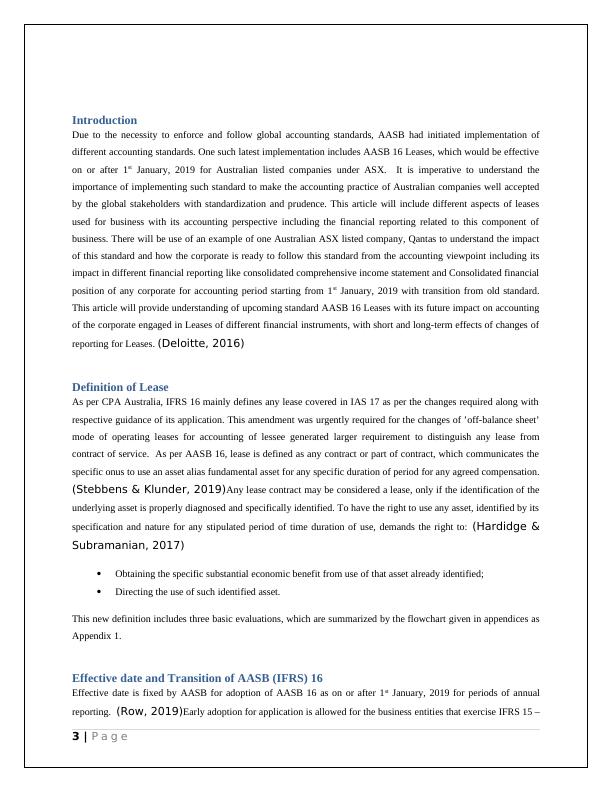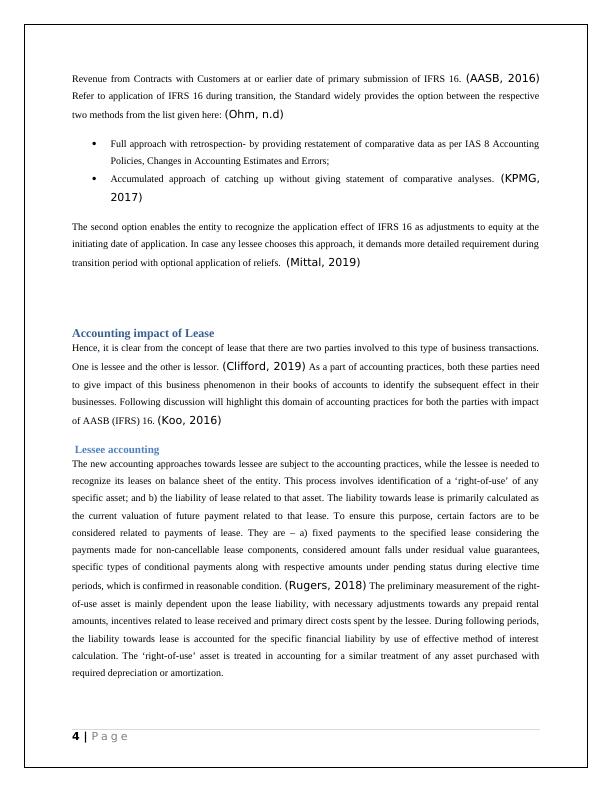Accounting for Leases – the impact of AASB (IFRS) 16
Accounting for Leases – the impact of AASB (IFRS) 16
15 Pages2905 Words389 Views
Added on 2022-11-10
About This Document
This article discusses the impact of AASB (IFRS) 16 on accounting for leases and financial reporting. It covers the definition of lease, effective date and transition, lessee and lessor accounting, necessary disclosures, and the impact on Qantas. The article provides a comprehensive understanding of the new standard and its implications for Australian companies with ASX listing.
Accounting for Leases – the impact of AASB (IFRS) 16
Accounting for Leases – the impact of AASB (IFRS) 16
Added on 2022-11-10
ShareRelated Documents
Accounting for Leases – the impact of AASB (IFRS) 16
Abstract
Australian Accounting Standard Board (AASB) has implemented AABS16 with effective date 1st January, 2019
related to Leases for corporate accounting to follow IFRS 16 implemented since January, 2016 by IASB or
International Accounting Standard Board. The IFRS 16 Leases would replace IAS 17 Leases for financial reporting
with effective periods starting on or after 1st January. 2019. Even the willing entities can implement this standard
earlier with application of the same to Revenue Recognition with Customers and Contracts – AASB 15. This article
will emphasize on the features of this accounting standard with its effect in the balance sheet of the entities from 1st
January 2019. This discussion would include exemplary projection from an Australian ASX listed company to
understand the accounting treatment of IFRS 16 Leases with its impact in financial reporting including balance
sheet.
Keywords: IFRS 16, Leases, AASB 16, Balance sheet, financial reporting.
1 | P a g e
Abstract
Australian Accounting Standard Board (AASB) has implemented AABS16 with effective date 1st January, 2019
related to Leases for corporate accounting to follow IFRS 16 implemented since January, 2016 by IASB or
International Accounting Standard Board. The IFRS 16 Leases would replace IAS 17 Leases for financial reporting
with effective periods starting on or after 1st January. 2019. Even the willing entities can implement this standard
earlier with application of the same to Revenue Recognition with Customers and Contracts – AASB 15. This article
will emphasize on the features of this accounting standard with its effect in the balance sheet of the entities from 1st
January 2019. This discussion would include exemplary projection from an Australian ASX listed company to
understand the accounting treatment of IFRS 16 Leases with its impact in financial reporting including balance
sheet.
Keywords: IFRS 16, Leases, AASB 16, Balance sheet, financial reporting.
1 | P a g e

Table of Contents
Introduction................................................................................................................ 3
Definition of Lease...................................................................................................... 3
Effective date and Transition of AASB (IFRS) 16.........................................................3
Accounting impact of Lease....................................................................................... 4
Lessee accounting................................................................................................... 4
Lessor accounting................................................................................................... 5
Necessary Disclosure in Annual Financial Report- compliance of IFRS 16...............5
QANTAS- The impact of AASB 16................................................................................ 5
Conclusion.................................................................................................................. 6
References................................................................................................................. 7
Appendices:................................................................................................................ 9
2 | P a g e
Introduction................................................................................................................ 3
Definition of Lease...................................................................................................... 3
Effective date and Transition of AASB (IFRS) 16.........................................................3
Accounting impact of Lease....................................................................................... 4
Lessee accounting................................................................................................... 4
Lessor accounting................................................................................................... 5
Necessary Disclosure in Annual Financial Report- compliance of IFRS 16...............5
QANTAS- The impact of AASB 16................................................................................ 5
Conclusion.................................................................................................................. 6
References................................................................................................................. 7
Appendices:................................................................................................................ 9
2 | P a g e

Introduction
Due to the necessity to enforce and follow global accounting standards, AASB had initiated implementation of
different accounting standards. One such latest implementation includes AASB 16 Leases, which would be effective
on or after 1st January, 2019 for Australian listed companies under ASX. It is imperative to understand the
importance of implementing such standard to make the accounting practice of Australian companies well accepted
by the global stakeholders with standardization and prudence. This article will include different aspects of leases
used for business with its accounting perspective including the financial reporting related to this component of
business. There will be use of an example of one Australian ASX listed company, Qantas to understand the impact
of this standard and how the corporate is ready to follow this standard from the accounting viewpoint including its
impact in different financial reporting like consolidated comprehensive income statement and Consolidated financial
position of any corporate for accounting period starting from 1st January, 2019 with transition from old standard.
This article will provide understanding of upcoming standard AASB 16 Leases with its future impact on accounting
of the corporate engaged in Leases of different financial instruments, with short and long-term effects of changes of
reporting for Leases. (Deloitte, 2016)
Definition of Lease
As per CPA Australia, IFRS 16 mainly defines any lease covered in IAS 17 as per the changes required along with
respective guidance of its application. This amendment was urgently required for the changes of ’off-balance sheet’
mode of operating leases for accounting of lessee generated larger requirement to distinguish any lease from
contract of service. As per AASB 16, lease is defined as any contract or part of contract, which communicates the
specific onus to use an asset alias fundamental asset for any specific duration of period for any agreed compensation.
(Stebbens & Klunder, 2019)Any lease contract may be considered a lease, only if the identification of the
underlying asset is properly diagnosed and specifically identified. To have the right to use any asset, identified by its
specification and nature for any stipulated period of time duration of use, demands the right to: (Hardidge &
Subramanian, 2017)
Obtaining the specific substantial economic benefit from use of that asset already identified;
Directing the use of such identified asset.
This new definition includes three basic evaluations, which are summarized by the flowchart given in appendices as
Appendix 1.
Effective date and Transition of AASB (IFRS) 16
Effective date is fixed by AASB for adoption of AASB 16 as on or after 1st January, 2019 for periods of annual
reporting. (Row, 2019)Early adoption for application is allowed for the business entities that exercise IFRS 15 –
3 | P a g e
Due to the necessity to enforce and follow global accounting standards, AASB had initiated implementation of
different accounting standards. One such latest implementation includes AASB 16 Leases, which would be effective
on or after 1st January, 2019 for Australian listed companies under ASX. It is imperative to understand the
importance of implementing such standard to make the accounting practice of Australian companies well accepted
by the global stakeholders with standardization and prudence. This article will include different aspects of leases
used for business with its accounting perspective including the financial reporting related to this component of
business. There will be use of an example of one Australian ASX listed company, Qantas to understand the impact
of this standard and how the corporate is ready to follow this standard from the accounting viewpoint including its
impact in different financial reporting like consolidated comprehensive income statement and Consolidated financial
position of any corporate for accounting period starting from 1st January, 2019 with transition from old standard.
This article will provide understanding of upcoming standard AASB 16 Leases with its future impact on accounting
of the corporate engaged in Leases of different financial instruments, with short and long-term effects of changes of
reporting for Leases. (Deloitte, 2016)
Definition of Lease
As per CPA Australia, IFRS 16 mainly defines any lease covered in IAS 17 as per the changes required along with
respective guidance of its application. This amendment was urgently required for the changes of ’off-balance sheet’
mode of operating leases for accounting of lessee generated larger requirement to distinguish any lease from
contract of service. As per AASB 16, lease is defined as any contract or part of contract, which communicates the
specific onus to use an asset alias fundamental asset for any specific duration of period for any agreed compensation.
(Stebbens & Klunder, 2019)Any lease contract may be considered a lease, only if the identification of the
underlying asset is properly diagnosed and specifically identified. To have the right to use any asset, identified by its
specification and nature for any stipulated period of time duration of use, demands the right to: (Hardidge &
Subramanian, 2017)
Obtaining the specific substantial economic benefit from use of that asset already identified;
Directing the use of such identified asset.
This new definition includes three basic evaluations, which are summarized by the flowchart given in appendices as
Appendix 1.
Effective date and Transition of AASB (IFRS) 16
Effective date is fixed by AASB for adoption of AASB 16 as on or after 1st January, 2019 for periods of annual
reporting. (Row, 2019)Early adoption for application is allowed for the business entities that exercise IFRS 15 –
3 | P a g e

Revenue from Contracts with Customers at or earlier date of primary submission of IFRS 16. (AASB, 2016)
Refer to application of IFRS 16 during transition, the Standard widely provides the option between the respective
two methods from the list given here: (Ohm, n.d)
Full approach with retrospection- by providing restatement of comparative data as per IAS 8 Accounting
Policies, Changes in Accounting Estimates and Errors;
Accumulated approach of catching up without giving statement of comparative analyses. (KPMG,
2017)
The second option enables the entity to recognize the application effect of IFRS 16 as adjustments to equity at the
initiating date of application. In case any lessee chooses this approach, it demands more detailed requirement during
transition period with optional application of reliefs. (Mittal, 2019)
Accounting impact of Lease
Hence, it is clear from the concept of lease that there are two parties involved to this type of business transactions.
One is lessee and the other is lessor. (Clifford, 2019) As a part of accounting practices, both these parties need
to give impact of this business phenomenon in their books of accounts to identify the subsequent effect in their
businesses. Following discussion will highlight this domain of accounting practices for both the parties with impact
of AASB (IFRS) 16. (Koo, 2016)
Lessee accounting
The new accounting approaches towards lessee are subject to the accounting practices, while the lessee is needed to
recognize its leases on balance sheet of the entity. This process involves identification of a ‘right-of-use’ of any
specific asset; and b) the liability of lease related to that asset. The liability towards lease is primarily calculated as
the current valuation of future payment related to that lease. To ensure this purpose, certain factors are to be
considered related to payments of lease. They are – a) fixed payments to the specified lease considering the
payments made for non-cancellable lease components, considered amount falls under residual value guarantees,
specific types of conditional payments along with respective amounts under pending status during elective time
periods, which is confirmed in reasonable condition. (Rugers, 2018) The preliminary measurement of the right-
of-use asset is mainly dependent upon the lease liability, with necessary adjustments towards any prepaid rental
amounts, incentives related to lease received and primary direct costs spent by the lessee. During following periods,
the liability towards lease is accounted for the specific financial liability by use of effective method of interest
calculation. The ‘right-of-use’ asset is treated in accounting for a similar treatment of any asset purchased with
required depreciation or amortization.
4 | P a g e
Refer to application of IFRS 16 during transition, the Standard widely provides the option between the respective
two methods from the list given here: (Ohm, n.d)
Full approach with retrospection- by providing restatement of comparative data as per IAS 8 Accounting
Policies, Changes in Accounting Estimates and Errors;
Accumulated approach of catching up without giving statement of comparative analyses. (KPMG,
2017)
The second option enables the entity to recognize the application effect of IFRS 16 as adjustments to equity at the
initiating date of application. In case any lessee chooses this approach, it demands more detailed requirement during
transition period with optional application of reliefs. (Mittal, 2019)
Accounting impact of Lease
Hence, it is clear from the concept of lease that there are two parties involved to this type of business transactions.
One is lessee and the other is lessor. (Clifford, 2019) As a part of accounting practices, both these parties need
to give impact of this business phenomenon in their books of accounts to identify the subsequent effect in their
businesses. Following discussion will highlight this domain of accounting practices for both the parties with impact
of AASB (IFRS) 16. (Koo, 2016)
Lessee accounting
The new accounting approaches towards lessee are subject to the accounting practices, while the lessee is needed to
recognize its leases on balance sheet of the entity. This process involves identification of a ‘right-of-use’ of any
specific asset; and b) the liability of lease related to that asset. The liability towards lease is primarily calculated as
the current valuation of future payment related to that lease. To ensure this purpose, certain factors are to be
considered related to payments of lease. They are – a) fixed payments to the specified lease considering the
payments made for non-cancellable lease components, considered amount falls under residual value guarantees,
specific types of conditional payments along with respective amounts under pending status during elective time
periods, which is confirmed in reasonable condition. (Rugers, 2018) The preliminary measurement of the right-
of-use asset is mainly dependent upon the lease liability, with necessary adjustments towards any prepaid rental
amounts, incentives related to lease received and primary direct costs spent by the lessee. During following periods,
the liability towards lease is accounted for the specific financial liability by use of effective method of interest
calculation. The ‘right-of-use’ asset is treated in accounting for a similar treatment of any asset purchased with
required depreciation or amortization.
4 | P a g e

End of preview
Want to access all the pages? Upload your documents or become a member.
Related Documents
The Regulatory Environment for Financial Reportinglg...
|6
|835
|56
Accounting for Leases - The Impact of AASB (IFRS 16)lg...
|8
|2957
|94
Assignment on Critical Thinkinglg...
|5
|875
|31
AASB 16: Impacts on Speedcast International Limitedlg...
|9
|2495
|29
The Regulatory Environment and Financial Reportinglg...
|7
|848
|75
Bottom Line of AASB 16/ IFRS 16lg...
|6
|2024
|86
